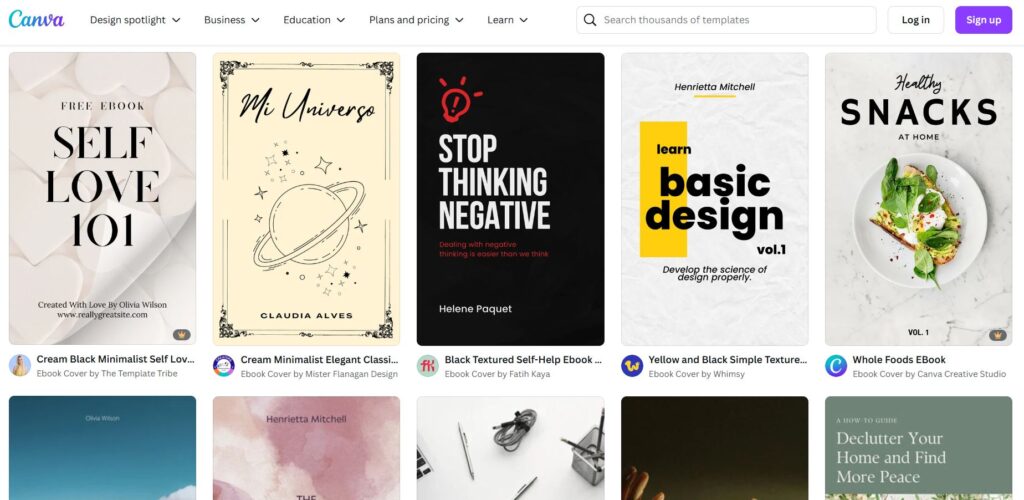The cover design of an ebook is usually the last thing on everybody’s mind. We spend hours and hours optimizing the content and crafting the perfect narrative. However, we don’t give much thought to the actual cover that would eventually present our work to the world.
If you’re just now starting to think about how to design an ebook cover, you’re at the right place! We’ll take you through 7 simple steps to create a stunning cover that will captivate potential readers and give your ebook the attention it deserves.
How to Design an eBook Cover
- Find a Good Design Tool
- Define the Dimensions
- Finalize the Color Scheme
- Select High-Quality Images
- Focus on Typography
- Create a Visual Hierarchy
- Test, Test, and Test
Let’s discuss these 7 steps on how to design an ebook cover in more detail below.
1. Find a Good Design Tool
A good design tool is crucial in creating a professional cover. If you have some experience in designing, you can opt for advanced tools such as Adobe Photoshop or Illustrator. But if you don’t want more complex functionalities, you can use online tools like Canva or Vista.
Canva, in particular, has a user-friendly drag-and-drop interface that you can use to create your ebook covers. In fact, you can even browse their pre-made templates to get some inspiration and avoid building everything from scratch.

2. Define the Dimensions
The dimensions of your ebook cover design can vary depending on several factors. These can include the length of your content, genre, the platform where you intend to publish, etc. In general, we follow these specifications:
- General eBook for the Web: 1563 x 2500 pixels
- Amazon Kindle: 1563 x 2500 pixels
- Barnes & Noble: 1333 x 2000 pixels
- Smashwords: 1600 x 2400 pixels
- Kobo Books: 1600 x 2400 pixels
- Apple iBooks: 1400 x 1873 / 1600 x 2400 pixels (recommended)
- Google Books: 1618 x 2500 pixels
- Draft 2 Digital: 1600 x 2400 pixels
- Lulu: 612 x 792 pixels
- Book Baby: 1400 x 2100 pixels
You can use these sizes or experiment with different dimensions to find the one that works best for your audience.
3. Finalize the Color Scheme
Before jumping into anything else, we recommend you finalize the color scheme of your ebook. The best thing is to stick to your branding colors if you have an established brand. This will help reinforce your identity and make your ebook instantly recognizable to your audience.
But again, there are no rules set in stone – feel free to experiment with different hues and combinations. Just make sure you find something that best captures the essence of your ebook and stands out in a crowded marketplace.
4. Select High-Quality Images
Adding images to the ebook cover is optional, but it does help in making it more intriguing and engaging. You can either choose royalty-free illustrations or stock images from websites such as Freepik, Unsplash, or Pexels.

Once you’ve selected your images, it’s important to customize them to align with your color scheme and overall design vision. You can copy them into your preferred design tools to start editing.
5. Focus on Typography
After images, we need to focus on the text. Apart from the main heading, you can add a subheading, synopsis, author’s name, brand name, and other relevant information to your ebook cover.
If you already have an established brand font, use them to reinforce your brand identity. Or choose something that reflects the tone and genre of your ebook. But the work doesn’t end here.
Typography involves understanding how to align text and manage spacing to create a visually appealing and readable design. Hence, you need to play with various sizes and placements to find the optimal layout. You have to make sure the title stands out prominently while the author’s name and any additional text remain legible in every screen size.
6. Create a Visual Hierarchy
Once you have arranged everything on your ebook cover, take an overview to assess the visual hierarchy. This means that you should evaluate whether the most important elements—such as the title and brand’s name—are immediately noticeable. They should be the focal point of your cover.
Then, your image or illustration should be positioned to complement the text and reflect the theme, genre, or mood of the ebook. Every other supporting element should be clearly visible but less dominant than the title.
7. Test, Test, and Test
You cannot skip this step! Start by reviewing how your cover looks in various formats and sizes, especially as a thumbnail image, since many readers will encounter it in a small format on digital platforms. Make sure you check the readability of the text and the visibility of key elements.
You can also consider gathering feedback from potential readers or your peers to get insights into how your cover is perceived. This feedback will help you refine the design to better align with reader preferences and expectations.
Summing Up: How to Design an eBook Cover
Learning how to design an ebook cover is pretty straightforward. However, if you find yourself struggling to create the perfect cover that truly captivates and engages your audience, consider hiring an expert!
Just sign up for our unlimited graphic design services and let us assist you in designing the ebook cover that meets your expectations and also stands out amongst everything else.



